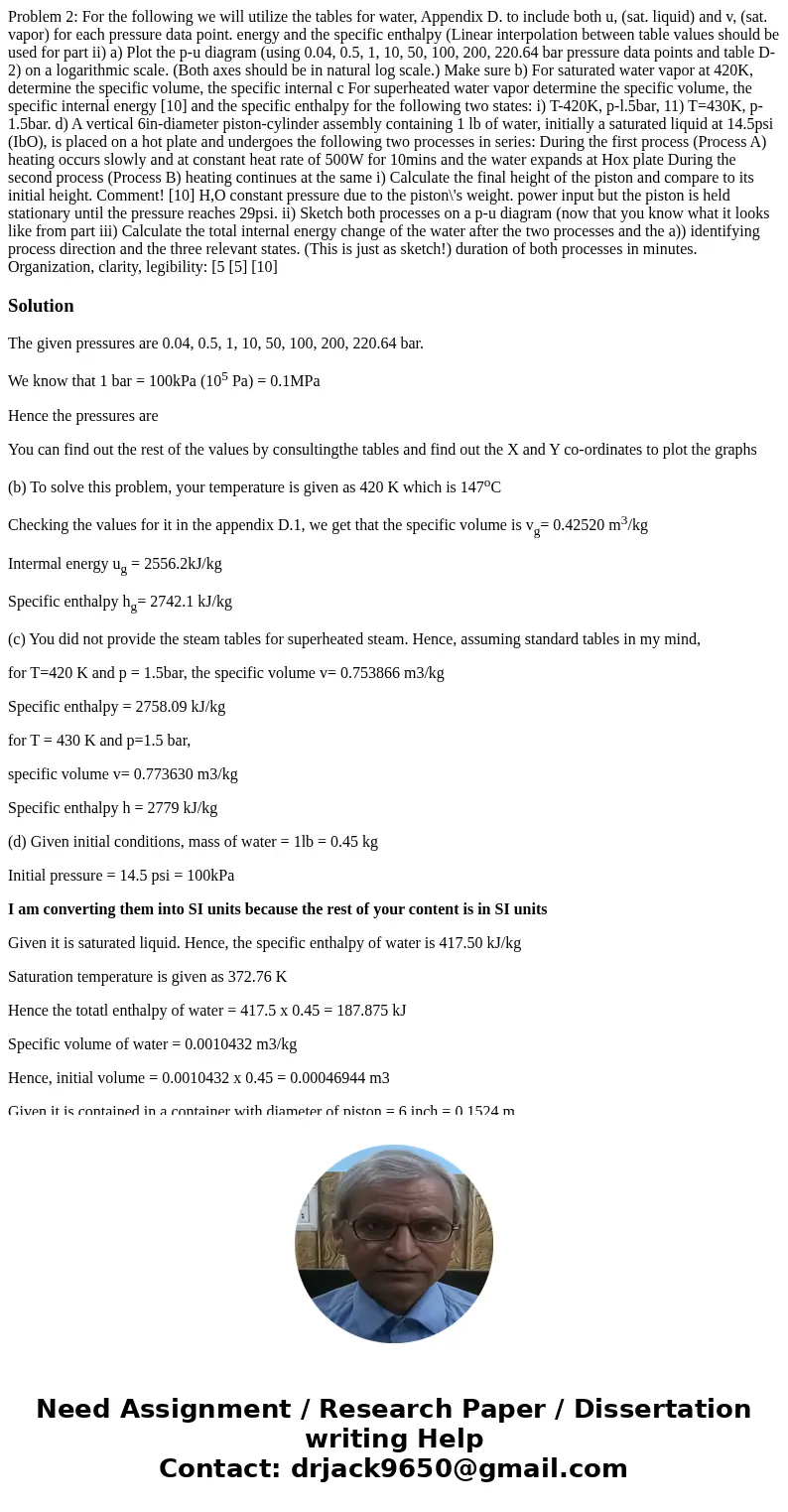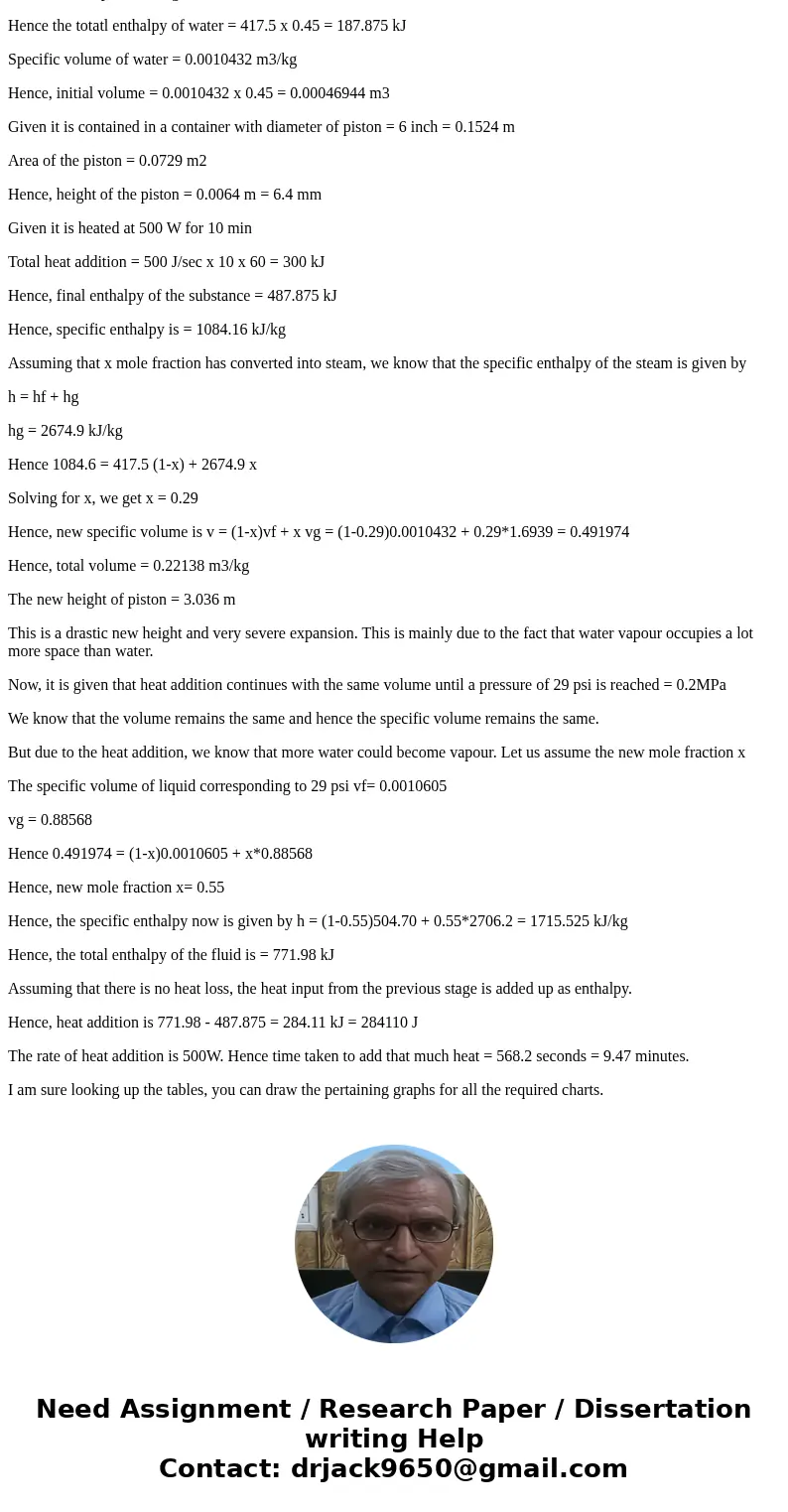Problem 2 For the following we will utilize the tables for w
Solution
The given pressures are 0.04, 0.5, 1, 10, 50, 100, 200, 220.64 bar.
We know that 1 bar = 100kPa (105 Pa) = 0.1MPa
Hence the pressures are
You can find out the rest of the values by consultingthe tables and find out the X and Y co-ordinates to plot the graphs
(b) To solve this problem, your temperature is given as 420 K which is 147oC
Checking the values for it in the appendix D.1, we get that the specific volume is vg= 0.42520 m3/kg
Intermal energy ug = 2556.2kJ/kg
Specific enthalpy hg= 2742.1 kJ/kg
(c) You did not provide the steam tables for superheated steam. Hence, assuming standard tables in my mind,
for T=420 K and p = 1.5bar, the specific volume v= 0.753866 m3/kg
Specific enthalpy = 2758.09 kJ/kg
for T = 430 K and p=1.5 bar,
specific volume v= 0.773630 m3/kg
Specific enthalpy h = 2779 kJ/kg
(d) Given initial conditions, mass of water = 1lb = 0.45 kg
Initial pressure = 14.5 psi = 100kPa
I am converting them into SI units because the rest of your content is in SI units
Given it is saturated liquid. Hence, the specific enthalpy of water is 417.50 kJ/kg
Saturation temperature is given as 372.76 K
Hence the totatl enthalpy of water = 417.5 x 0.45 = 187.875 kJ
Specific volume of water = 0.0010432 m3/kg
Hence, initial volume = 0.0010432 x 0.45 = 0.00046944 m3
Given it is contained in a container with diameter of piston = 6 inch = 0.1524 m
Area of the piston = 0.0729 m2
Hence, height of the piston = 0.0064 m = 6.4 mm
Given it is heated at 500 W for 10 min
Total heat addition = 500 J/sec x 10 x 60 = 300 kJ
Hence, final enthalpy of the substance = 487.875 kJ
Hence, specific enthalpy is = 1084.16 kJ/kg
Assuming that x mole fraction has converted into steam, we know that the specific enthalpy of the steam is given by
h = hf + hg
hg = 2674.9 kJ/kg
Hence 1084.6 = 417.5 (1-x) + 2674.9 x
Solving for x, we get x = 0.29
Hence, new specific volume is v = (1-x)vf + x vg = (1-0.29)0.0010432 + 0.29*1.6939 = 0.491974
Hence, total volume = 0.22138 m3/kg
The new height of piston = 3.036 m
This is a drastic new height and very severe expansion. This is mainly due to the fact that water vapour occupies a lot more space than water.
Now, it is given that heat addition continues with the same volume until a pressure of 29 psi is reached = 0.2MPa
We know that the volume remains the same and hence the specific volume remains the same.
But due to the heat addition, we know that more water could become vapour. Let us assume the new mole fraction x
The specific volume of liquid corresponding to 29 psi vf= 0.0010605
vg = 0.88568
Hence 0.491974 = (1-x)0.0010605 + x*0.88568
Hence, new mole fraction x= 0.55
Hence, the specific enthalpy now is given by h = (1-0.55)504.70 + 0.55*2706.2 = 1715.525 kJ/kg
Hence, the total enthalpy of the fluid is = 771.98 kJ
Assuming that there is no heat loss, the heat input from the previous stage is added up as enthalpy.
Hence, heat addition is 771.98 - 487.875 = 284.11 kJ = 284110 J
The rate of heat addition is 500W. Hence time taken to add that much heat = 568.2 seconds = 9.47 minutes.
I am sure looking up the tables, you can draw the pertaining graphs for all the required charts.


 Homework Sourse
Homework Sourse